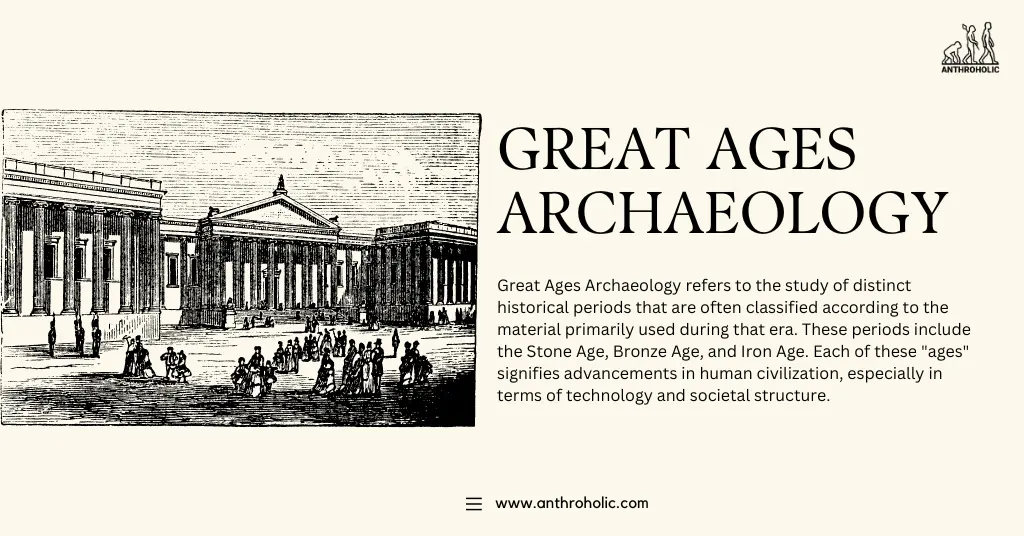AI Answer Evaluation Platform Live Now. Try Free Answer Evaluation Now
Great Ages Archaeology
Great Ages Archaeology refers to the study of distinct historical periods that are often classified according to the material primarily used during that era. These periods include the Stone Age, Bronze Age, and Iron Age. Each of these “ages” signifies advancements in human civilization, especially in terms of technology and societal structure.

Stone Age
- Paleolithic: The “Old Stone Age” saw the development of simple stone tools. It is further divided into Lower, Middle, and Upper Paleolithic, marking significant advancements in tool-making techniques and cognitive development.
- Mesolithic: This period signifies a transition from hunter-gatherer societies to farming communities, leading to permanent settlements.
- Neolithic: The “New Stone Age” marked the advent of agriculture and animal domestication, resulting in more sophisticated social organization.
Bronze Age
This age saw the invention and widespread use of bronze, an alloy of copper and tin. This period marked advancements in metalworking, leading to the creation of more complex tools, weapons, and architectural structures.
Iron Age
The Iron Age is characterized by the widespread use of iron and steel. This period marked significant improvements in technology and marked the foundation of early historical periods.
The classification of these ages often overlaps and varies by geographical region due to the asynchronous nature of technological advancements across different civilizations.
Radiometric Dating and Half-Life: Unearthing the Timeline
Understanding the concept of half-life is crucial to establishing the timeline of these great ages. This is because radiometric dating techniques, which often rely on the concept of half-life, are used to date archaeological finds.
Understanding Half-Life
In physics, half-life is the time required for half the atoms in a sample of a radioactive isotope to decay into another element. This is a fixed, deterministic property of each radioactive isotope. For example, the half-life of Carbon-14, a commonly used isotope in archaeological dating, is about 5,730 years1.
Radiocarbon Dating
This method measures the decay of Carbon-14 in organic materials to estimate their age. This is particularly useful in dating artifacts from the great ages, especially the latter part of the Stone Age and subsequent periods.
Potassium-Argon Dating
This technique is ideal for dating older archaeological finds. It measures the decay of Potassium-40 to Argon-40 and is particularly useful in dating early hominid fossils.
| Radiometric Dating Method | Useful Range | Material Dated |
|---|---|---|
| Radiocarbon | up to 60,000 years | organic materials (wood, bone, shell) |
| Potassium-Argon | from 100,000 years to billions of years | volcanic rocks and minerals2 |
The Significance of Archaeological Anthropology
Archaeological Anthropology provides invaluable insights into human evolution and cultural development. By studying artifacts and the environment in which they were found, archaeologists reconstruct the human past, gaining insights into ancient cultures and societies.
The application of scientific techniques like radiometric dating, grounded on principles such as half-life, enables archaeologists to build a chronological sequence of the great ages. This, in turn, helps unravel the cultural, technological, and social evolution of our species.
Impact of Archaeology on Our Understanding of History
While written history often focuses on notable figures or large-scale events, archaeology provides a broader perspective. By uncovering everyday items such as tools, pottery, and the remnants of structures, archaeologists reveal insights about the lives of common people1. Such findings help researchers understand societal structure, economic systems, and cultural practices of the past.
Stone Age: Dawn of Human Innovation
The Stone Age offers the earliest evidence of human ingenuity, with stone tools and weapons marking a significant leap in survival strategies. In the Paleolithic era, humans developed tools for hunting, such as hand axes and spears. These tools were fundamental in human migration and interaction with diverse environments2.
The shift to the Neolithic era saw the invention of agriculture. This fundamental change in food production led to the formation of settled communities, setting the stage for the growth of civilization.
Bronze Age: Onset of Urbanization
The Bronze Age marked a shift from stone to metal, offering greater durability and versatility in tool creation. Bronze tools and weapons were more effective and durable than their stone counterparts, leading to advancements in warfare, agriculture, and craftsmanship3.
The Bronze Age also saw the rise of urban civilizations, with societies growing more complex. Settlements became larger, evolving into cities, and social hierarchies began to solidify.
Iron Age: Evolution of Societies
The Iron Age was marked by the development of iron smelting, which allowed for the creation of even more advanced tools and weapons. This period also witnessed the emergence of established states and empires, and advancements in art, culture, and technology4.
Radiometric Dating: Illuminating the Timeline
Radiometric dating techniques, using the principle of half-life, provide archaeologists with reliable tools to establish a timeline for the Great Ages. By measuring the decay of isotopes within artifacts or surrounding materials, archaeologists can estimate the time when an object was last heated or when an organism died.
The following table summarizes the relevance of different isotopes in the dating process:
| Isotope | Half-Life | Relevant Dating Range | Materials Dated |
|---|---|---|---|
| Carbon-14 | 5,730 years | up to 60,000 years | Organic materials |
| Potassium-40 | 1.3 billion years | from 100,000 years to billions of years | Volcanic rocks and minerals5 |
Radiocarbon Dating: Unveiling the Recent Past
Radiocarbon dating involves the decay of Carbon-14 to Nitrogen-14. As living organisms continually absorb Carbon-14 from the environment, the ratio of Carbon-14 to stable carbon isotopes remains constant during their lifetime. At death, this absorption ceases, and the Carbon-14 present starts decaying, allowing for the estimation of the time elapsed since death6.
Potassium-Argon Dating: Probing Deep into the Past
Potassium-Argon dating, on the other hand, is particularly useful for dating very old archaeological materials. This method involves the decay of Potassium-40 to Argon-40, providing an effective tool for dating early hominid sites and volcanic deposits7.
Conclusion: The Interplay of Archaeology and Science
In conclusion, Great Ages Archaeology and the concept of half-life, fundamental to radiometric dating, play critical roles in the field of Archaeological Anthropology. By dating artifacts and providing a timeline for the great ages, scientists can construct a detailed picture of human evolution and cultural development.
References
- “Half-Life.” Encyclopædia Britannica. https://www.britannica.com/science/half-life-physics-chemistry
- Renfrew, C., & Bahn, P. (2020). Archaeology: Theories, methods, and practice (8th ed.). Thames & Hudson.
- Hodder, I. (2012). Archaeological theory: A brief introduction (2nd ed.). John Wiley & Sons.
- Scarre, C. (2005). The human past: World prehistory & the development of human societies. Thames & Hudson.
- Fagan, B. M. (2005). Ancient North America: The archaeology of a continent (4th ed.). Thames & Hudson.
- Cunliffe, B. (2008). Iron Age communities in Britain: An account of England, Scotland, and Wales from the seventh century BC until the Roman conquest (4th ed.). Routledge.
- Aitken, M. J. (1990). Science-based dating in archaeology. Longman.
- Taylor, R. E., & Bar-Yosef, O. (2014). Radiocarbon dating: An archaeological perspective (2nd ed.). Routledge.
- McDougall, I., & Harrison, T. M. (1999). Geochronology and thermochronology by the 40Ar/39Ar method (2nd ed.). Oxford University Press.



